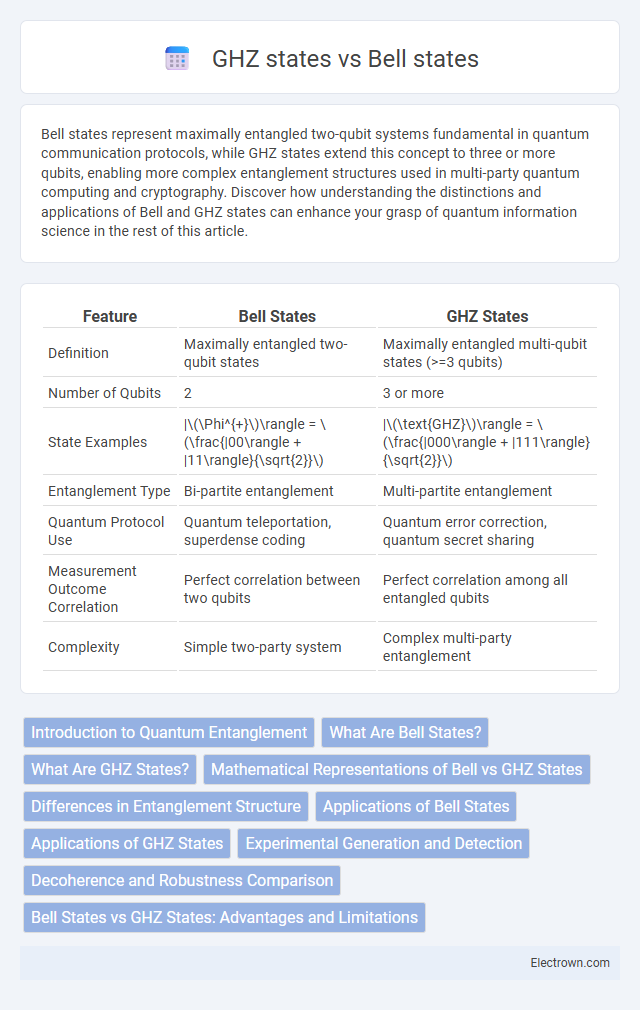Bell states represent maximally entangled two-qubit systems fundamental in quantum communication protocols, while GHZ states extend this concept to three or more qubits, enabling more complex entanglement structures used in multi-party quantum computing and cryptography. Discover how understanding the distinctions and applications of Bell and GHZ states can enhance your grasp of quantum information science in the rest of this article.
Table of Comparison
| Feature | Bell States | GHZ States |
|---|---|---|
| Definition | Maximally entangled two-qubit states | Maximally entangled multi-qubit states (>=3 qubits) |
| Number of Qubits | 2 | 3 or more |
| State Examples | |\(\Phi^{+}\)\rangle = \(\frac{|00\rangle + |11\rangle}{\sqrt{2}}\) | |\(\text{GHZ}\)\rangle = \(\frac{|000\rangle + |111\rangle}{\sqrt{2}}\) |
| Entanglement Type | Bi-partite entanglement | Multi-partite entanglement |
| Quantum Protocol Use | Quantum teleportation, superdense coding | Quantum error correction, quantum secret sharing |
| Measurement Outcome Correlation | Perfect correlation between two qubits | Perfect correlation among all entangled qubits |
| Complexity | Simple two-party system | Complex multi-party entanglement |
Introduction to Quantum Entanglement
Quantum entanglement is a fundamental phenomenon where particles become interconnected, such that the state of one instantly influences the state of another, regardless of distance. Bell states represent the simplest form of entanglement involving two qubits, enabling key protocols like quantum teleportation and superdense coding. In contrast, GHZ (Greenberger-Horne-Zeilinger) states extend entanglement to three or more qubits, proving essential for complex quantum computing algorithms and multi-party quantum cryptography.
What Are Bell States?
Bell states represent maximally entangled two-qubit quantum states fundamental in quantum information theory and quantum computing. These four specific states, named after physicist John Bell, exhibit perfect correlations that defy classical explanations and serve as essential resources for quantum teleportation, superdense coding, and quantum cryptography. Understanding Bell states helps you leverage entanglement properties critical for protocols demonstrating nonlocality and secure quantum communication.
What Are GHZ States?
GHZ states are a type of entangled quantum state involving three or more qubits, representing a key extension beyond the two-qubit Bell states. They exhibit maximal entanglement, enabling complex quantum correlations that cannot be explained by classical physics, making them crucial for quantum computing and quantum communication protocols. Understanding GHZ states enhances your ability to harness multipartite entanglement for advanced quantum information processing tasks.
Mathematical Representations of Bell vs GHZ States
Bell states are maximally entangled two-qubit states represented mathematically as \(|\Phi^\pm\rangle = \frac{1}{\sqrt{2}}(|00\rangle \pm |11\rangle)\) and \(|\Psi^\pm\rangle = \frac{1}{\sqrt{2}}(|01\rangle \pm |10\rangle)\), forming a basis for two-qubit systems. GHZ states extend entanglement to three or more qubits, expressed as \(|\text{GHZ}\rangle = \frac{1}{\sqrt{2}}(|000\rangle + |111\rangle)\), capturing multipartite entanglement with non-local correlations beyond pairwise interactions. The distinct mathematical structures of Bell and GHZ states highlight fundamental differences in quantum correlations, with Bell states involving bipartite superpositions and GHZ states representing tripartite superpositions in Hilbert space.
Differences in Entanglement Structure
Bell states represent two-qubit entanglement with maximal correlations between pairs, whereas GHZ states extend this concept to three or more qubits, creating multi-party entanglement that cannot be decomposed into pairwise entanglements. The entanglement structure of Bell states is bipartite and symmetric, allowing perfect correlations between two parties, while GHZ states exhibit genuine multipartite entanglement, meaning the entanglement is shared collectively across all qubits. Understanding these differences helps you leverage the appropriate quantum resource for tasks like quantum communication or distributed quantum computing.
Applications of Bell States
Bell states are fundamental in quantum communication protocols such as quantum teleportation and superdense coding, enabling secure and efficient transfer of quantum information. These entangled two-qubit states form the basis for quantum key distribution schemes like BB84, enhancing the security of your cryptographic systems. Their robustness in detecting eavesdropping makes Bell states essential for developing practical quantum networks and secure communication channels.
Applications of GHZ States
GHZ states, or Greenberger-Horne-Zeilinger states, play a crucial role in quantum information processing, enabling advanced protocols like multi-party quantum communication and quantum secret sharing. Unlike Bell states that involve two-qubit entanglement, GHZ states extend entanglement to three or more qubits, making them essential for tasks involving multipartite entanglement verification and quantum error correction. Your ability to harness GHZ states allows for robust quantum networks and enhanced secure communication protocols.
Experimental Generation and Detection
Bell states are experimentally generated using spontaneous parametric down-conversion in nonlinear crystals, enabling precise generation of entangled photon pairs with high fidelity. GHZ states require more complex setups involving multiple entangled photons, often produced through cascaded down-conversion or multi-photon interference in linear optics, posing greater challenges for scalable generation. The detection of Bell states is typically achieved with standard polarization analyzers and coincidence counters, while GHZ state detection demands synchronized multi-particle measurements and advanced techniques like quantum state tomography to verify genuine multipartite entanglement.
Decoherence and Robustness Comparison
Bell states exhibit less complexity and greater robustness against decoherence in two-qubit systems, maintaining entanglement under typical noise conditions more effectively than GHZ states. GHZ states, involving three or more qubits, are highly sensitive to environment-induced decoherence, causing rapid deterioration of multipartite entanglement. Your choice between Bell and GHZ states should consider the trade-off between entanglement utility and vulnerability to decoherence in practical quantum information tasks.
Bell States vs GHZ States: Advantages and Limitations
Bell states, representing maximally entangled two-qubit pairs, are fundamental in quantum communication protocols due to their simpler generation and robustness against decoherence, enabling reliable quantum key distribution and teleportation. GHZ states extend entanglement to three or more qubits, offering advantages in multipartite quantum computing and enhanced quantum metrology, but are more susceptible to noise and require complex preparation. The trade-off between Bell states' stability and GHZ states' scalability highlights their distinct roles: Bell states excel in bipartite tasks, while GHZ states enable richer correlations for advanced quantum networks and error correction schemes.
Bell states vs GHZ states Infographic

 electrown.com
electrown.com